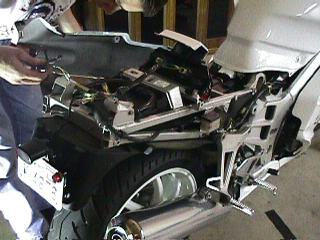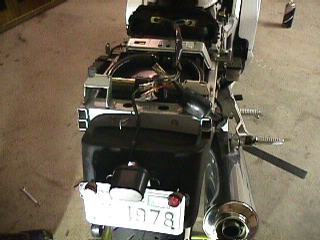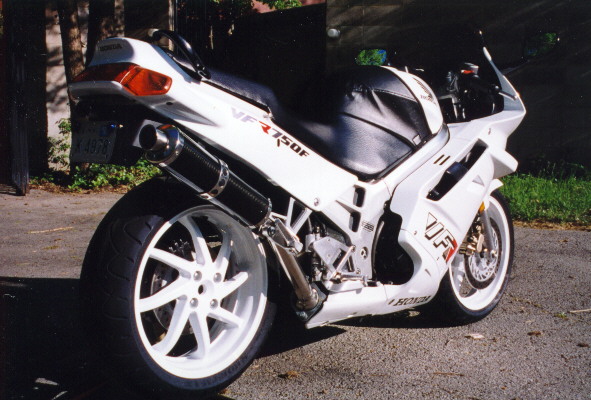

Periodically I have to beat into my head the limited options for rear shock upgrade on the late model VFR's (94 and later, I believe) so here are the results of some phone calls:
Works - No, only to 1993
Fox- Nope, and don't plan on making one.
Two Brothers Racing- Since they were Pridmore sponsors, I figured they'd have an option. No, used to get them from Fox till they 'went crazy on us'.
Ohlins- $900
Lindemann- rework of O.E.M. for around $200, if I remember correctly.
Race Tech- said they would make a custom spring (I need a heavier spring to set proper sag for a big guy) and rework the O.E.M. shock for $500. Ouch!
Additional info by John Z. Holtrichter:
Another option is the Hagon replacement shock (w/spring, 2 yr. warranty, adjustable damping and preload) from M&P (http://www.mandp.com) in the UK. The catalog lists one for the early (G,H,J &K) models, and another for the L ('90) model. As I'm "in the area," I gave Hagon a call +44 (181) 502-6222, and they told me that the second shock will fit all VFRs from '90 through '96. Both cost GBP198 which, when exported (i.e., directly shipped out of the country by M&P, thus exempt from the 17.5% VAT) is equivalent to $270 (w/o shipping). I don't think the shock has the easily-adjusted screw-type preload adjuster like the stock shock, (Hagon said they include a wrench for the adjustment of the collar on the bottom of the shock), but sure is cheaper than almost anything else. From people who have used them, I have heard that the shock is nothing special, but works about as well as the Honda shock.
More additional info submitted by Kevin Glick:
Penske makes Remote reservior shocks for 90-97 VFR's. Cost: US$695 with Spring. They have higher priced models with low AND high speed damping adjustments but you're talking US$900-1200.
Available Adjustments on US$695 model:
Spring Preload: threaded body type (infinite)To add running light function to rear signals (as on the front); Go to auto store,buy 2 generic dual filament bulbs (turn/stop bulbs), #1157 I think (8W/23W).Cheap.Or go to Honda dealer & pay 3X for front signal bulbs,your choice....
Order from Honda;Left front socket assembly,pt.#33455-MT4-671 Right front socket assembly,pt.#33405-MT4-671 Paid about $28 from local overpriced dealer,YMMV...
Wire colors are as follows for those who don't have service manual;Instructions;
1-remove tailpieceMUCH improved rear visibility for about $35 & about an hour (not that the average pinhead motorist will notice-I doubt most drivers would notice a 747 landing on the X-way coming toward them with landing lights blazing...the things I've seen....
Fiamm 'snail' horn installationI recently installed a set of Fiamm horns in my '94 VFR and thought I would pass along my experiences. The horns are the "snail" type. Fiamm also makes air-trumpets and flat disk-type horns. The snail type seem to be the best compromise between size and loudness.
1. Electrical Considerations-- The stock horn is switched directly by the horn switch. The increased current draw of the Fiamms is likely to damage the switch contacts, so a relay must be used. Use an automotive style relay with a current rating of 30 amps or more (try Radio Shack's 275-226, a rather universal one). The horns are not going to actually draw 30 amps of current, but they represent an inductive load (like a motor) so the heavy contacts are important. Wiring from the relay to the new horns should be adequate in gauge, but there's no need for overkill. I compromised on 18 gauge, noting that BMW horn wiring for a pair of Fiamms is closer to 22 gauge. I choose to run a ground wire as well,although frame ground will be satisfactory in most cases.
2. Mechanical Considerations--The VFR was not designed to have lots of aftermarket accessories crammed under the fairing. Mounting space is at a premium and some ingenuity will be required to mount a pair of Fiamm horns. The horns themselves are not identical to each other; think of one as the "right" and the other as its mirror-image. This fact will become important when it comes to mounting, as one horn will fit in a particular location better than its counterpart.
I found that the stock mounting brackets that came with the horns were fine, but needed a few custom bends. To gain extra clearance, I discarded the plastic decorative covers on each horn. I also removed the chrome grills and pared down the flared section of each horn, first with a hacksaw then with a die grinder. The material is plastic and is easy to work with, and removing the flare makes the horn much more compact. The Fiamm instructions are fairly worthless (obviously written by the same fellow who wrote the Givi instructions), but pay attention to the allowable mounting orientation. The horns must be able to drain any water which gets into them or they will fail.
3. Mounting-- I ended up mounting the first horn directly above the coolant recovery tank, using the bolt which holds the tank to a tab coming off the frame of the bike. The fit is very tight, and only one of the horn pair will fit properly. Once installed, the coolant tank filler will be blocked by the horn, so unbolting the horn bracket will be necessary if/when you need to add coolant...less than a five minute job, though. When installing the horn in this location, the limiting factor will be clearance to the mid-fairing, particularly the plastic louvers. Be sure you have that clearance before you force the fairing back into position....
The second horn is easier. It mounts directly below the coolant tank, bolting to an elongated slot already in the tank's bracket. My only concern about this location was its proximity to the exhaust pipe for the right front cylinder. I found that the horn body (plastic side) ran quite warm after prolonged idling, but was cool if the bike was moving. To be on the safe side, I covered the plastic area of the horn with aluminum tape, similar to the stuff Honda uses in the same area to protect the fairing parts from the heat. Now the horn actually runs cooler than the fairing pieces do.
4. Why Bother?--Mounting and wiring a pair of Fiamm horns will take several hours if you do a methodical, neat job of it. Plus, the horns will set you back about $40. Why not just stay with the stock horn?
Fiamms are god-awful loud. Painfully loud, even with ear protection and a helmet on. They WILL wake the dead, and WILL be heard by the deaf, the distracted and the disinterested. Do continue to cover your front brake, but plan on using it much less frequently once the Fiamm horns are installed. I have put them on every car and bike I have owned in the past ten years, and wouldn't even consider staying with stock horns now.
H4 headlight conversion for '90+ VFRs and Blue Ion BulbsHere are a couple sources for Blue Ion and other H4 bulbs:
Competition Ltd: http://www.htnews.com/comptltd
Jeff Knights: http://www.qni.com/~nyztyz/tenzo/index1.htm
Inexpensive VFR Throttle LockMany have asked about Throttle Locks for VFRs. The primary use is to rest your right hand on those long distance rides. The 2 choices are a Throttlemeister or an O-ring lock.
The Throttlemeister is machined metal (stainless I think?) bar-end replacements. The right bar-end houses a locking mechanism that when twisted, creates enough friction to hold the throttle in place. From everyone I've heard the quality of these bar-ends is very high, but so is the price about $100.
The other alternative is an O-ring (about $97.50 cheaper). One that fits perfectly on VFRs is Caterpillar Part #8M5266. Installation is simple, place the O-ring on the right bar-end. When ready to engage the throttle lock roll the O-ring towards the throttle grip until it rests in the valley between the end of the grip and the bar-end. The O-ring does NOT fall into the valley, it simply rides on top of the valley. It also creates enough friction to hold the throttle in place.
Caterpiller O-ring Specs:Note: The term Throttle Lock is really a misnomer. These devices simply create friction so the throttle doesn't return to the idle position. With the "lock" FULLY engaged, you can change the throttle position to increase or decrease speed.
Turn Signal Mod - '90-'93

